
The Battle of Bosworth or Bosworth Field was the last significant battle of the Wars of the Roses, the civil war between the houses of Lancaster and York that extended across England in the latter half of the 15th century. Fought on 22 August 1485, the battle was won by an alliance of Lancastrians and disaffected Yorkists. Their leader Henry Tudor, Earl of Richmond, became the first English monarch of the Tudor dynasty by his victory and subsequent marriage to a Yorkist princess. His opponent Richard III, the last king of the House of York, was killed during the battle, the last English monarch to die in combat. Historians consider Bosworth Field to mark the end of the Plantagenet dynasty, making it one of the defining moments of English history.

Richard III was king of England from 26 June 1483 until his death in 1485. He was the last king of the Plantagenet dynasty and its cadet branch the House of York. His defeat and death at the Battle of Bosworth Field, the last decisive battle of the Wars of the Roses, marked the end of the Middle Ages in England.

The Battle of Stoke Field on 16 June 1487 may be considered the last battle of the Wars of the Roses, since it was the last major engagement between contenders for the throne whose claims derived from descent from the houses of Lancaster and York respectively. The Battle of Bosworth Field, two years previously, had established King Henry VII on the throne, ending the last period of Yorkist rule and initiating that of the Tudors. The Battle of Stoke Field was the decisive engagement in an attempt by leading Yorkists to unseat him in favour of the pretender Lambert Simnel.

John Howard, 1st Duke of Norfolk, also known as Jack of Norfolk,, was an English nobleman, soldier, politician, and the first Howard Duke of Norfolk. He was a close friend and loyal supporter of King Richard III, with whom he was slain at the Battle of Bosworth in 1485.
Sir Robert Brackenbury was an English courtier, who was Constable of the Tower of London during the reign of Richard III. He is believed to have been responsible for enabling the (presumed) murders of the Princes in the Tower, though there is no conclusive evidence to prove it. He died defending the King at the Battle of Bosworth Field in 1485.

Sir William Brandon of Soham, Cambridgeshire was Henry Tudor's standard-bearer at the Battle of Bosworth, where he was killed by King Richard III. He was the father of Charles Brandon, 1st Duke of Suffolk.

Sutton Cheney is a village and former civil parish, now in the parish of Dadlington and Sutton Cheney, in the borough of Hinckley and Bosworth, in the county of Leicestershire, England, near the county border with Warwickshire. In addition to the village of Sutton Cheney itself, the civil parish also contains the villages of Dadlington and Shenton, a number of farms, and the location of the Battle of Bosworth. Its closest large towns are Nuneaton and Hinckley. Its closest market town is Market Bosworth.

The Oriflamme, a pointed, blood-red banner flown from a gilded lance, was the sacred battle standard of the King of France and a symbol of divine intervention on the battlefield from God and Saint Denis in the Middle Ages. The oriflamme originated as the sacred banner of the Abbey of St. Denis, a monastery near Paris. When the oriflamme was raised in battle by the French royalty during the Middle Ages, most notably during the Hundred Years' War, no prisoners were to be taken until it was lowered. Through that tactic, they hoped to strike fear into the hearts of the enemy, especially the nobles, who could usually expect to be taken alive for ransom during such military encounters.

The Honourable The King's Champion is an honorary and hereditary office in the Royal Household of the British sovereign. The champion's original role at the coronation of a British monarch was to challenge anyone who contested the new monarch's entitlement to the throne to trial by combat. Although this function was last enacted at the coronation of George IV in 1821, the office continues to descend through the Dymoke family.
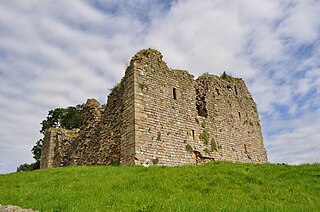
Thirlwall Castle is a 12th-century castle in Northumberland, England, on the bank of the River Tipalt close to the village of Greenhead and approximately 20 miles (32 km) west of Hexham. It was built in the 12th century, and later strengthened using stones from nearby Hadrian's Wall, but began to fall into disrepair in the 17th century. The site is protected by Grade I listed building and Scheduled Ancient Monument status.
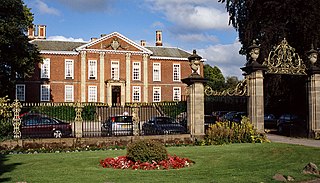
Bosworth Hall is a historic country house and Grade II* listed building in the rural town of Market Bosworth in Leicestershire, England, now known as the Bosworth Hall Hotel. It was the country seat of the Dixie family for nearly three hundred years. Since the 1980s the house has had several owners and is now a hotel.

Hobart Van Zandt Bosworth was an American film actor, director, writer, and producer. Bosworth began his career in theater, eventually transitioning to the emerging film industry. Despite a battle with tuberculosis, he found success in silent films, establishing himself as a lead actor and pioneering the industry in California. Bosworth started his own production company, Hobart Bosworth Productions, in 1913, focusing on Jack London melodramas. After the company closed, Bosworth continued to act in supporting roles, surviving the transition to sound films. He is known as the "Dean of Hollywood" for his role in shaping the California film industry. In 1960, Bosworth was awarded a star on the Hollywood Walk of Fame for his contributions to the film industry.
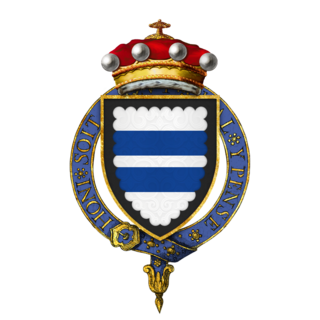
Sir William Parr, KG (1434–1483) was an English courtier and soldier. He was the eldest son of Sir Thomas Parr (1405–1461) and his wife Alice, daughter of Sir Thomas Tunstall of Thurland, Lancashire.

Walter Devereux, 8th Baron Ferrers of Chartley, KG was an English nobleman and a loyal supporter of the House of York during the Wars of the Roses. He was a member of the inner circle of King Edward IV, and died fighting for Edward's younger brother, King Richard III, at the Battle of Bosworth in 1485.
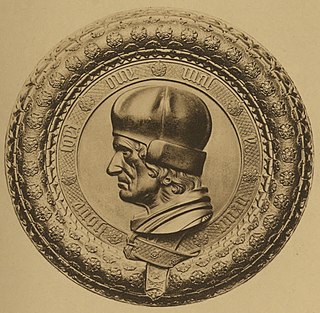
Sir Thomas Lovell, KG was an English soldier and administrator, Speaker of the House of Commons, Secretary to the Treasury and Chancellor of the Exchequer.
The Standard Bearer of England was once an important office within the English army, especially during the times when Kings were still present on the battlefield. As standard-bearer Henry de Essex was greatly chastised when he threw down the English Standard and claimed his King (Stephen) was dead in 1153.

The Dixie Baronetcy was created in the Baronetage of England at the time of the Restoration of the Monarchy in 1660 for Sir Wolstan Dixie (1602–1682), a supporter of King Charles I during the English Civil War and afterwards. He was descended from a brother of Sir Wolstan Dixie, the sixteenth century Lord Mayor of London who founded the Dixie Professorship of Ecclesiastical History in the University of Cambridge. Their home was Bosworth Hall near Market Bosworth in Leicestershire. The title became extinct with the death of the thirteenth Baronet, another Sir Wolstan Dixie, in 1975.

John Harington, 1st Baron Harington (1281–1347) of Aldingham in Furness, Lancashire, was an English peer, created Baron Harington by writ of summons to Parliament dated 1326.
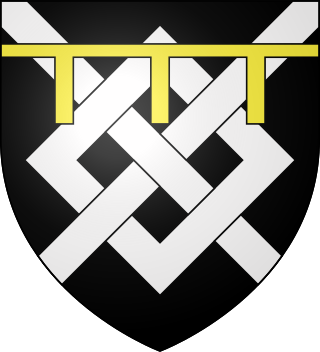
Sir James Harrington of Hornby was an English politician and soldier who was a prominent Yorkist supporter in Northern England during the Wars of the Roses, having been retained by Richard Neville, 5th Earl of Salisbury, who was brother-in-law to the head of the House of York, Richard of York. He was the second son of Sir Thomas Harrington, who had died with the king's father at the Battle of Wakefield in December 1460. James himself had fought with Salisbury at the Battle of Blore Heath in 1459, where he had been captured and imprisoned by the Lancastrians until the next year. He was a significant regional figure during the reign of King Edward IV, although the early years of the new king's reign were marred by a bitter feud between him and the Stanley family over a castle in Lancashire. On the accession of King Richard III in 1483, he was appointed to the new king's Household, and as such was almost certainly with him at the Battle of Bosworth Field two years later. It is likely that he fell in battle there, although precise details of his death are now unknown.

Sir John Savage, KG, KB, PC (1444–1492), was an English knight of the Savage family, who was a noted military commander of the late 15th-century. Savage most notably fought at the Battle of Bosworth Field in 1485, where he commanded the left flank of the Tudor (Lancastrian) army to victory and is said to have personally slain the Duke of Norfolk in single combat. Earlier in the Wars of the Roses, Savage had been a supporter and friend of the Yorkist King Edward IV, fighting alongside him and helping him to victories at the Battle of Barnet in 1471 and the Battle of Tewkesbury later that same year, as well as joining the Duke of Gloucester's invasion of Scotland in 1482, where the Duke made him a Knight banneret. However, following the death of Edward and the Duke of Gloucester's ascension to the throne as Richard III the Savage family was viewed with suspicion due to their familial connection to the Stanleys, who were in turn connected to the Tudors. Consequently Savage was one of the prominent figures who invited Henry Tudor to invade England in 1485, a struggle which culminated in the Battle of Bosworth Field. After his victory Henry Tudor received the circlet of Richard from Savage's uncle Lord Stanley and was crowned King of England on the field of battle, taking the throne as Henry VII of England.


















